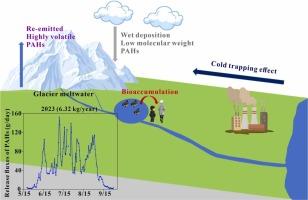祁连山老湖沟12号冰川多环芳烃释放:时间动态、输送机制和通量
IF 11.3
1区 环境科学与生态学
Q1 ENGINEERING, ENVIRONMENTAL
引用次数: 0
摘要
研究了12号老湖沟冰川整个消融季多环芳烃的释放特征、通量及潜在生态风险。结果表明,多环芳烃的总负荷范围为51.2 ~ 388.2 ng/L,其中溶解性多环芳烃(DPAHs)占主导地位。DPAHs和微粒结合PAHs (PPAHs)浓度分别在消融早期(5月)和强化消融期(7月下旬)达到峰值。三环多环芳烃含量最高,DPAHs的平均分子量显著低于PPAHs。多环芳烃的日变化规律不明显,而多环芳烃的日变化规律明显,白天升高,夜间降低。低分子量多环芳烃主要在夜间释放,而高分子量多环芳烃则以白天释放为主。影响多环芳烃释放的环境因子较少,而多环芳烃释放主要受径流和悬浮颗粒物控制。老虎沟12号冰川PAHs年释放通量达到6.32 kg/年,7 - 8月由于PAHs浓度峰值和径流影响,释放通量显著升高。同时,多环芳烃会对底栖生物的生存产生不利影响。本研究首次评估了青藏高原冰川的多环芳烃释放通量,为预测气候变化下亚洲高山冰川加速退缩对下游生态的影响提供了关键的基线数据。本文章由计算机程序翻译,如有差异,请以英文原文为准。

Polycyclic aromatic hydrocarbons released from Laohugou Glacier No. 12 in the Qilian Mountains: temporal dynamics, transport mechanisms and fluxes
Accelerated glacier retreat on the Tibetan Plateau is transforming high-altitude glaciers from pollutant sinks into secondary emission sources of polycyclic aromatic hydrocarbons (PAHs). This study investigated the release characteristics, fluxes, and potential ecological risks of PAHs during the whole ablation season of Laohugou Glacier No. 12. The results show that the total PAHs load ranged from 51.2 to 388.2 ng/L, with dissolved PAHs (DPAHs) dominating the total load. Concentrations of DPAHs and particulate-bound PAHs (PPAHs) peaked during the early ablation season (May) and the intensive ablation period (late July), respectively. Three-ring PAHs were the most abundant, and the average molecular weight of DPAHs was significantly lower than that of PPAHs. DPAHs exhibited no significant diurnal variation pattern, whereas PPAHs concentrations exhibited a distinct diurnal pattern with daytime increases and nighttime decreases. Low-molecular-weight PAHs tended to be released predominantly at night, while high-molecular-weight PAHs showed preferential daytime release. DPAHs release was influenced by fewer environmental factors, while PPAHs release was primarily controlled by runoff and suspended particulate matter. The annual release flux of PAHs from Laohugou Glacier No. 12 reached 6.32 kg/year, with significantly elevated fluxes in July–August due to peak PAHs concentrations and runoff. Meanwhile, PPAHs could adversely affect the survival of benthic organisms. This study provides the first assessment of PAHs release fluxes from the TP glaciers, offering critical baseline data for predicting the downstream ecological impacts of accelerated glacier retreat across High Mountain Asia under climate change.
求助全文
通过发布文献求助,成功后即可免费获取论文全文。
去求助
来源期刊

Journal of Hazardous Materials
工程技术-工程:环境
CiteScore
25.40
自引率
5.90%
发文量
3059
审稿时长
58 days
期刊介绍:
The Journal of Hazardous Materials serves as a global platform for promoting cutting-edge research in the field of Environmental Science and Engineering. Our publication features a wide range of articles, including full-length research papers, review articles, and perspectives, with the aim of enhancing our understanding of the dangers and risks associated with various materials concerning public health and the environment. It is important to note that the term "environmental contaminants" refers specifically to substances that pose hazardous effects through contamination, while excluding those that do not have such impacts on the environment or human health. Moreover, we emphasize the distinction between wastes and hazardous materials in order to provide further clarity on the scope of the journal. We have a keen interest in exploring specific compounds and microbial agents that have adverse effects on the environment.
 求助内容:
求助内容: 应助结果提醒方式:
应助结果提醒方式:


